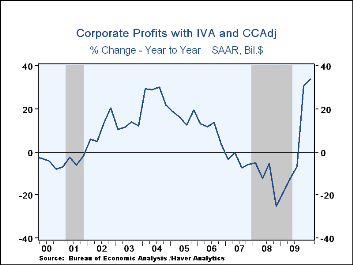 Global| Dec 09 2010
Global| Dec 09 2010U.S. Initial Unemployment Insurance Claims Down 17K
Summary
Initial claims for unemployment insurance fell back last week to 421,000 from 438,000 during the prior period (revised from 436,000). The trend level continued downward as the four-week moving average fell to 427,500, yet another new [...]

 Initial claims for unemployment insurance fell back last week to
421,000 from 438,000 during the prior period (revised from 436,000).
The trend level continued downward as the four-week
moving average fell to 427,500, yet another new low since July 2008. The
latest weekly figure was modestly below consensus forecasts for 425,000
claims.
Initial claims for unemployment insurance fell back last week to
421,000 from 438,000 during the prior period (revised from 436,000).
The trend level continued downward as the four-week
moving average fell to 427,500, yet another new low since July 2008. The
latest weekly figure was modestly below consensus forecasts for 425,000
claims.
Continuing claims for state-administered programs dropped 191,000 in the November 27 week to 4,086,000, the low since November 15, 2008. The associated unemployment rate decreased to 3.2% from 3.4% the previous week. These claimants are, however, only about half of the total number of people currently receiving unemployment insurance. Regular "extended benefits", with eligibility dependent on conditions in individual states, fell back from 955,928 on November 13 to 795,733 on November 20, the latest figure available. The other extra program, Emergency Unemployment Compensation program, referred to as EUC 2008, fell back in the November 20 week by 233,032 to 3.711 million.
A grand total of all claimants for unemployment insurance includes extended and emergency programs and specialized programs covering recently discharged veterans, federal employees and people in state-run "workshare" programs, among others. All together, on November 13, the total number of all program recipients was 8.298 million, down 13.1% y/y. These individual program data are not seasonally adjusted.
Before we get too excited about the renewed decline in initial claims, we are cautioned by a colleague at a client firm that the week after Thanksgiving usually sees a big increase in actual initial claims, so the seasonal factor for that week experiences a sizable upswing, implying lower seasonally adjusted results. Further, all of the continuing claims figures have recently shown a week-to-week saw-tooth pattern, also indicating hesitation and tenuous conditions in labor markets. We can hope that improvement is developing, but these data do not appear to be conclusive on that.
Data on weekly unemployment insurance programs are contained in Haver's WEEKLY database and summarized monthly in USECON. Data for individual states, including the unemployment rates that determine individual state eligibility for the extended benefits programs and specific "tiers" of the emergency program, are in REGIONW, a database of weekly data for states and various regional divisions.
| Unemployment Insurance (000s) | 11/27/10 | 11/20/10 | 11/20/10 | Y/Y % | 2009 | 2008 | 2007 |
|---|---|---|---|---|---|---|---|
| Initial Claims | 421 | 438 | 410 | -12.8 | 572 | 419 | 321 |
| Continuing Claims | -- | 4,086 | 4,277 | -22.4 | 5,809 | 3,340 | 2,549 |
| Insured Unemployment Rate(%) | -- | 3.2 | 3.4 | 4.0 (11/09) |
4.4 | 2.5 | 1.9 |
| Total "All Programs" (NSA)* | -- | -- | 8.298M | -13.1% | 9.170M | 3.931M | 2.634M |
Carol Stone, CBE
AuthorMore in Author Profile »Carol Stone, CBE came to Haver Analytics in 2003 following more than 35 years as a financial market economist at major Wall Street financial institutions, most especially Merrill Lynch and Nomura Securities. She has broad experience in analysis and forecasting of flow-of-funds accounts, the federal budget and Federal Reserve operations. At Nomura Securites, among other duties, she developed various indicator forecasting tools and edited a daily global publication produced in London and New York for readers in Tokyo. At Haver Analytics, Carol is a member of the Research Department, aiding database managers with research and documentation efforts, as well as posting commentary on select economic reports. In addition, she conducts Ways-of-the-World, a blog on economic issues for an Episcopal-Church-affiliated website, The Geranium Farm. During her career, Carol served as an officer of the Money Marketeers and the Downtown Economists Club. She has a PhD from NYU's Stern School of Business. She lives in Brooklyn, New York, and has a weekend home on Long Island.





